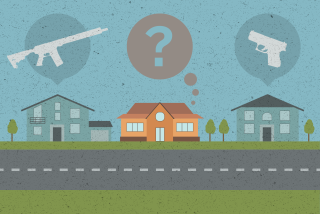A year after Newtown shootings, psychologists weigh in on gun violence
The risk that an American male will commit violence with a firearm is no easy thing to measure, says a comprehensive new report issued on the eve of the Sandy Hook Elementary School shooting’s first anniversary.
If he is to become the perpetrator in one of the 109,000 gun-related deaths and injuries that occur each year in the United States, this male (and in more than 90% of cases, it is a male) is likely to have been dealt a lifelong series of toxic exposures and steady challenges, and to have gotten little help in dealing with them.
His setbacks may start in utero, with drug exposure, poor maternal nutrition or the stress of a mother’s daily life. They likely continue through a childhood in which such factors as impulsiveness and a difficult temperament, inattentive or permissive parenting, poor academic performance, and a stream of signals condoning violent behavior conspire to make him aggressive. Along the way, red flags -- or cries for help -- will likely have gone unnoticed or ignored.
But whatever the resulting contents of his mind -- be it rage, depression, callousness or delusion -- the fateful sequence always ends the same way: He finds a gun in his hand.
If we really want to understand, predict, and prevent gun violence in the United States, this is the breadth of analysis that is necessary, says a panel of experts called upon by the American Psychological Assn.
Their report, issued Thursday, is not without recommendations -- some that will be controversial, others that are indisputable.
The panelists say that “the practice of keeping all firearms appropriately stored and locked must become the only socially acceptable norm” -- fighting words to those who believe their safety depends on having their guns always at the ready. Universal background checks, an initiative rebuffed again this year by gun rights advocates, can reduce the diversion of guns to criminals, they note. And they venture into politically sensitive territory in noting that prohibitions on firearm ownership among high risk groups -- including domestic violence offenders, those who have been convicted of violent misdemeanor crimes, and those with mentally illness who have been found legally to be a threat to themselves or others -- have been shown to reduce violent crime.
Elsewhere, however, the psychologists who penned the report simply speak the truth: that some children, through no fault of their own, appear to be fed into a “cradle-to-prison” pipeline of disadvantage and community violence; that the system of mental health care in the United States is woefully inadequate to the task of helping all who are troubled and potentially violent; and that without much better research, any effort to predict who will become violent will set up a dragnet that could target and stigmatize many who will never act violently.
At the same time, the panel notes that “prevention does not require prediction.” Fixing communities, helping families and treating troubled individuals is a dragnet of sorts, but one that could have effects well beyond preventing the violent use of firearms.
In short, reducing gun violence is not simple, and won’t be quick. But focusing on the larger picture could not only save 31,000 lives lost and prevent 78,000 injuries yearly: It could make us a much better, and healthier, society.
[For the record 2:07 p.m. PST Dec. 11: An earlier version of this post reported that the expert panel asserted that prevention requires prediction. The panel said that prevention does not require prediction.]
ALSO:
Guns: Doctors’ next big fight?
New gun-violence research agenda unveiled
Guns and alcohol: Gun owners drink more and take more risks, study says







